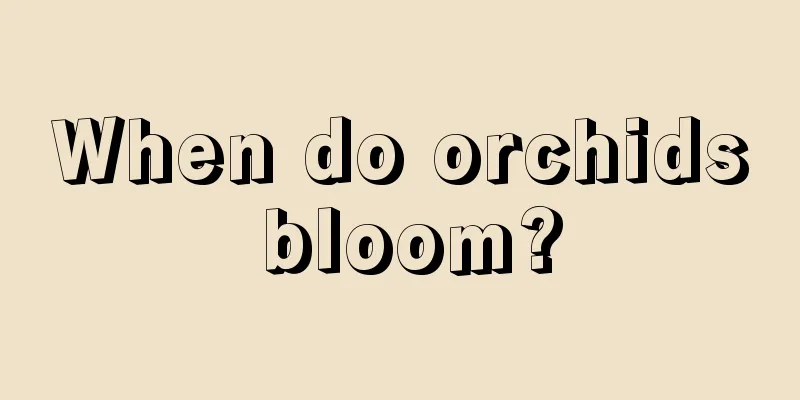When do orchids bloom?

|
Orchid is a traditional famous flower in China, known for its elegance, beautiful and noble flower shape, and profound cultural heritage. Many people keep one in their homes. So when do orchids bloom? Let’s learn more about it below. When do orchids bloom? There are many varieties of orchids, and their flowering time is not fixed. Basically, if they are properly maintained, different orchids will bloom throughout the year. For example, spring orchids usually bloom in February and March; cymbidium orchids usually bloom in March and May; winter orchids usually bloom in June and July; Jian orchids usually bloom from July to October; and black orchids usually bloom in November in winter, and can continue until February of the following year. Why don’t orchids bloom? 1. The orchid seedlings are too small Orchid seedlings (seed seedlings) generally take about 4 years to become capable of reproduction. Some orchid lovers grow orchids from dragon root and dragon egg seedlings. They themselves have not yet reached the "reproductive" age, and may not bloom for two or three years. This is very normal. 2. Insufficient light Orchids need an appropriate amount of light for photosynthesis, which in turn promotes the formation of flower buds. If placed in a dark environment for a long time, the growth of orchids will be inhibited and it will be difficult to bloom. 3. Temperature is too low When the temperature is too low, orchids will not bloom, because in a long-term low temperature environment, the normal growth function of orchids will be inhibited and they may even enter a dormant stage. In addition, if the temperature is too low, the orchid may easily be frostbitten. 4. Improper fertilization Excessive fertilization leading to nutrient excess or too much nitrogen fertilizer will cause the orchid branches to grow vigorously and inhibit the differentiation of flower buds, thus preventing it from blooming. 5. Improper watering Long-term drought or excessive watering may be the reason why orchids do not bloom. The correct solution is to follow the principle of "watering when dry and watering when wet" when watering orchids , that is, keep the soil moist but not too wet. 6. Planting material issues The root system of orchids is fleshy. It is easy to rot, so the planting material must be drained, breathable and nutritious. Try to simulate the original environment. If the planting material is not air permeable, the growth and flowering of orchids will be restricted. In general, orchids have different varieties blooming throughout the year, but the prerequisite is that good maintenance work must be done. The focus should be on taking appropriate measures to improve the growth environment of orchids to promote their flowering.
|
<<: Trumpet creeper's requirements for light and soil acidity and alkalinity
>>: Does trumpet creeper like water or the sun?
Recommend
How to water succulents in summer
When to water succulents in summer In summer, it ...
Will Clematis freeze to death during the winter?
1. Will I freeze to death? Although it is cold-re...
How to grow Begonia in winter?
Begonia , also known as Begonia and Tiger Ear Beg...
Pick up these "3 kinds" of materials on the roadside, take them home and make them into "fertilizers", and all flowers will grow vigorously!
1. Pine Needles It is winter now, and many trees ...
How to grow cinnabar orchid
Vermilion Orchid Soil Cinnabar orchids prefer wel...
How to grow a caterpillar cactus
Caterpillar Cactus Growing Conditions Caterpillar...
Black skin winter melon price
1. Price At present, there is a great demand for ...
Complete list of pesticide formulas, how to make and produce pesticides
1. Formula 1. Pesticides prepared with different ...
Is it better to use water-soluble fertilizer or compound fertilizer for fruit trees (can compound fertilizer be mixed with water to water fruit trees)?
I grow apples. As for whether chemical fertilizer...
How to care for and water Monstera?
Monstera is known for its unique leaf texture and...
How and when to plant daisy seeds: soak for several hours before sowing
To harvest daisy seeds, you have to wait until th...
How to grow Christmas cactus in summer
3 tips for growing flowers in summer ventilation ...
How to grow banyan trees
Banyan Tree Growing Conditions Banyan trees prefe...
Hang the flowers on the ceiling and they will grow into big flower balls, which are beautiful and save space!
Million Bells The flowers of Million Bells are sh...
Can I grow an apricot tree at home?
Can I grow an apricot tree at home? It is possibl...









